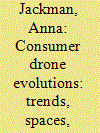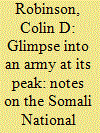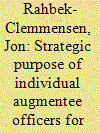|
|
|
Sort Order |
|
|
|
Items / Page
|
|
|
|
|
|
|
| Srl | Item |
| 1 |
ID:
170276


|
|
|
|
|
| Summary/Abstract |
The aim of the current study is to discuss which particular factors Russia considers as sufficient deterrent capabilities and whether the national defence models implemented in the Baltic countries have the potential to deter Russia's military planners and political leadership. Whilst the existing conventional reserves of NATO are sizeable, secure, and rapid, deployment is still a critical variable in case of a conflict in the Baltic countries because of the limited range of safe transportation options. However, whilst the Baltic States are developing their capabilities according to the priorities defined by NATO in 2010; which were updated after the invasion of Crimea in 2014, Russian military planners have meanwhile redesigned both their military doctrine and military forces, learning from the experience of the Russo-Georgian war, the Russia-Ukraine conflict, and other recent confrontations. Accordingly, there is a risk that the efforts of the Baltic countries could prove rather inefficient in deterring Russia.
|
|
|
|
|
|
|
|
|
|
|
|
|
|
|
|
| 2 |
ID:
170274


|
|
|
|
|
| Summary/Abstract |
While the drone has become synonymous with the War on Terror, the asymmetric iconography of the battlefield is shifting. Commercially available off-the-shelf (COTS) drones are increasingly prevalent features of global battlefields, employed by non-state actors in both visualising such spaces, and the directing and inflicting of harm. As such usage increases, so too do concerns around their evolving adoption, adaptation, and potential portability into homeland spheres. While cognizant of the range of positive drone applications, it is asserted that drones nonetheless remain simultaneously bound to an inverse potential for exploitation. In examining drone risk, this article approaches the consumer drone through a series of sites and spaces through which it is technically and socially constructed. Reflecting upon industry innovation, community-driven experimentation, and evolving airspace – it calls for greater attention to the drone’s malleability, arguing that understandings of COTS drones must remain attentive to both drone potential and potential drone threat.
|
|
|
|
|
|
|
|
|
|
|
|
|
|
|
|
| 3 |
ID:
170277


|
|
|
|
|
| Summary/Abstract |
Bagayoko, Hutchful, and Luckham correctly argue that the structures, characteristics, and operating methods of official security institutions in Africa have been somewhat neglected, with a lack of much recent research. The Somali National Army (SNA) sits among these lacunae. Its formal structures can be used as a skeletal starting point and springboard to start to draw the network diagrams that chart informal linkages. This is why recent declassification decisions by U.S. intelligence bodies, coupled with period documents released to the UK National Archives, hold significance in helping us understand early hierarchical SNA arrangements. They show the steady build-up in size of the force, to 1987, to about the time the civil war began to fragment the state.
|
|
|
|
|
|
|
|
|
|
|
|
|
|
|
|
| 4 |
ID:
170273


|
|
|
|
|
| Summary/Abstract |
This article examines the strategic purpose of Individual Augmentee Officers (IAOs) for junior partners in multinational military operations through an exploratory case study of Danish IAOs in Iraq and South Sudan between 2014 and 2017. IAOs are individual officers who are moved from their normal functions to be seconded to other units of the armed forces of their own or another country or an international institution. The study concludes that IAOs function as strategically important, yet not necessarily indispensable, supplements to military contingents in several ways: making tangible contributions to the overall mission (contributing), gaining access to information, knowledge, and experience (learning), and lobbying decision-making processes within mission headquarters (lobbying). The usefulness of IAOs depends on whether the junior partner has specific interests and a significant presence in the theatre and whether the mission is conducted as a UN mission, a NATO mission, or an ad hoc coalition.
|
|
|
|
|
|
|
|
|
|
|
|
|
|
|
|
| 5 |
ID:
170275


|
|
|
|
|
| Summary/Abstract |
German security and defence policy has undergone substantial transformation. This transformation requires an unprecedented level of political leadership, suggesting that Germany needs to solve the dilemma of how to supply leadership to increasingly demanding partners. What are the conditions under which German leadership can unfold in security and defence policy? To what degree do German role-conceptions of international agency and role-expectations of German leadership coincide? What kind of leadership outputs are produced? This study offers a comprehensive analysis of German security and defence policy in terms of supply (role conceptions) and demand (role expectations). We outline three leadership role conceptions present in the German strategic debate, which we then assess in the context of the Wendtian theory of cultures of anarchy. We then analyse Berlin's leadership in terms of outputs via the case study on Anchor Army and the Framework Nations Concept. We conclude that while Germany has tried to match leadership role expectations both rhetorically and in action, Berlin's leadership inputs have so far been insufficient. This has led to an imbalance in terms of role conceptions and expectations hampering effective German leadership in security and defence policy.
|
|
|
|
|
|
|
|
|
|
|
|
|
|
|
|
|
|
|
|
|